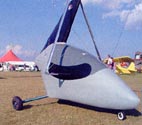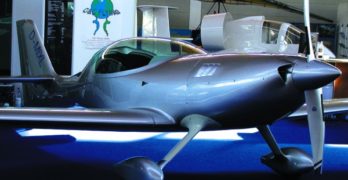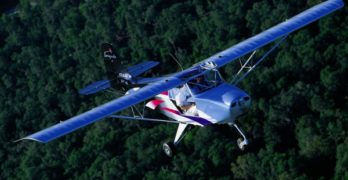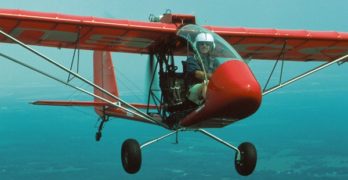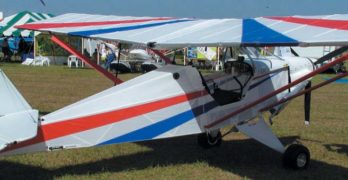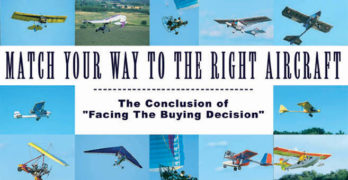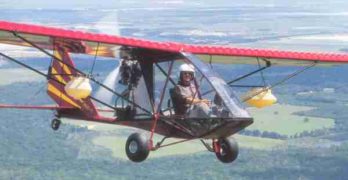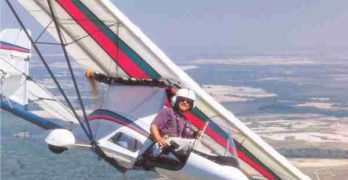Part 103 ultralight trikes aim at soaring pilots.
Many visitors to Oshkosh AirVenture 2003 expected the FAA to announce its new sport pilot/light-sport aircraft rule. New Administrator Marion Blakey reported signing off on the rule on July 30, but with two other agencies in line to review it, we aren’t likely to see the final version until 2004.
Visitors may not have expected to see more than a few Part 103 ultralight aircraft at AirVenture (some thought they would disappear as LSA approaches). But there were many. Next month I’ll write about two Part 103 rotary-wing aircraft, but this time, the subject is nanotrikes.
Nanotrike is a term to describe extremely light wheeled structures combining powered paraglider engines and contemporary hang glider wings. The idea is to create a low-cost, self-launching ultralight motorglider.
Trike Pod
Minnesota-based Seagull Aerosports debuted its Escape Pod at Oshkosh. Pushed by a single-cylinder Cors-Air engine generating 25 hp, the Escape Pod weighs only 75 pounds.
Search Results for : MG 21
Not finding exactly what you expected? Try our advanced search option.
Select a manufacturer to go straight to all our content about that manufacturer.
Select an aircraft model to go straight to all our content about that model.
Europe’s Biggest Light Aircraft Show
Light-sport aircraft are a major part of Aero 2003
My first visit to the Aero show was in 2001. For years earlier, I’d been aware of this event in the far south of Germany, in the resort town of Friedrichshafen. After attending the show two years ago, I became aware of how important it would be to light-sport aircraft.
Because Aero runs on alternate years, like many air shows in Europe, I determined I was going again in 2003, no matter what. Once again it was a worthwhile trip.
Friedrichshafen sits on the northern shore of a giant lake called Bodensee or Lake Constance. Across the body of water to the south lies Switzerland. Bodensee’s eastern edge borders Austria. The tourist attractions generated by the big lake come with picturesque scenes in many directions.
Friedrichshafen is also home to the Zeppelin airship company. Famous for its creation of the Hindenburg, Zeppelin is the oldest continuously operating airship builder.
On An Escapade
Just Aircraft’s Excapade … certificated in England and ready for sport pilots!
Southwestern Idaho has long been a hub of aircraft activity. With ranches and towns settled in great distances, it’s not surprising that aviation, once an established mode of transportation, quickly became popular in that part of the west. It’s also not surprising, then, that the area has been a hub of aircraft building activity. Here’s the story of one aircraft that’s evolved from that heritage.
In 1983, a two-seat, steel tube and fabric aircraft called the Avid Flyer made its first appearance at EAA’s annual convention. Describing the new design in the October 1983 issue of EAA Sport Aviation, then editor Jack Cox wrote, “Dan Denney of Boise, Idaho, was the person with the idea from which sprang the Avid Flyer. He wanted ‘something between ultralights and homebuilts’|(and) Dan had a friend uniquely qualified to transform that (idea) into|an airplane, Dean Wilson.”
What Denney and Wilson demonstrated to the fly-in crowd that year might be called the forerunner of the pending light-sport aircraft category|even at a time when ultralights were still gaining their foothold.
Light Sport Aircraft Specifications
How do we evaluate light-sport aircraft?
The FAA’s proposed SportPlanes™ /light-sport aircraft (LSA) rule is being discussed in hangars across America. But it is also being discussed at airports all over Europe—more than you may think. The global reach of this initiative is visible by the large number of European suppliers aiming their sights on the huge U.S. market. Many believe they have an aircraft that fits the standard.
In the previous issue of KITPLANES®, you read Brian E. Clark’s summary of how European aircraft manufacturers are responding to LSA. In this issue, you can look at Barnaby Wainfan’s analysis of the aerodynamics of aircraft that meet the standard.
In concert, this column attempts to add information about LSA candidate aircraft that are flying now. I’ve had the pleasure to fly many of the aircraft that may one day call themselves LSAs. In that flying, I’ve learned some lessons about what you might expect and how to evaluate what interests you.
Ultralight Trainer from RANS
“RANS is back!”
said many ultralight enthusiasts when the company offered their production version of the S-17 Stinger in September, 1999. Now the Kansas company has reaffirmed their commitment to the ultralight community by offering an enlarged S-17 with an added, tandem seat. Welcome to the S-18 Stinger II.
Of course this isn’t the first ultralight trainer from RANS. They continue to sell their S-12XL Airaile 2-seater. Others may observe that the S-6 Coyote 2-place can be built to operate within the limits of the Part 103 training exemption.
But when RANS first talked about their single-place Stinger – the prototype model that was never marketed – the company had been going in another direction. In those days the apparent darling of the company was the S-16 Shekari that is more accurately described as competition for Van’s RV series than as an ultralight. RANS president Randy Schlitter was able to see that ultralights didn’t simply grow up and become “light aircraft.” And, since Schlitter wants a share of the ultralight community, the S-17 single-place Stinger was his 1999 entry to entice ultralight flyers to the RANS brand name.
New Ultralights at Sun ‘n Fun
New ultralights and light aircraft were featured at Sun ‘n Fun
As flying season begins, Florida’s popular Sun ’n Fun airshow brings a focus on new aircraft of all types. Aviation writers review the new machines revealed at the event. Yet many machines are often overlooked in the rush to place the most attention-getting aircraft onto magazine covers and into survey articles. This month, we cover a few ultralights and light aircraft you should find interesting.
While aircraft like Titan’s T-51 Mustang, Just Aircraft’s Escapade, Airborne’s XT and Sabre’s Wildcat garnered lots of attention, designers of other ultralights have also been working hard.
Ramphos
One machine no one had seen before was the Ramphos amphibious trike. Though the amphibious trike concept has been used by numerous other companies, the Ramphos has features the others have lacked such as its counter-rotating propeller.
A prior model required a small vertical tail and distinguished itself by a composite hoop surrounding the propeller arc.
How-to-Buy a Lightplane — Part 3 of 3
In the previous two installments, we’ve discussed you, the pilot, and the many types of aircraft choices you have. As we wrap up this series, we’ll put it all together and try to help you narrow your choices to a few models.
Notice the word “try.” It is important that you understand that it is not possible to direct you to the one-and-only best choice of aircraft. Novice buyers often seek assistance but even experienced pilots can become swayed and end up purchasing the wrong aircraft for their needs and desires. Because aircraft purchases are commonly emotional decisions, it is helpful to gain a “second opinion” to help make a more rational choice.
Many years ago, at the beginning of my career writing articles in light aviation, I made a similar attempt to help hang glider pilots choose the right glider. I compared nine contemporary models to an idealized “perfect” glider and through a series of questions much like those below, tried to steer pilots to the one right glider for them.
The First Two Ultralights with the New HKS Engine
It isn’t often I can do “scouting party” duty on engines. Powerplants aren’t normally my focus. They
are a necessity for flight, but they aren’t my main attraction. A great many pilots I’ve met appear to be just the reverse: They are extremely interested in engines.
I enjoyed the chance to fly behind the first European and first American installations of the new 60-hp HKS 700E 4-stroke from Japan’s HKS Company Ltd. With that in mind, this pilot’s report is rather different. We’ll look at this new engine on two different aircraft.
As all Ultralight Flying! readers know, Rotax has enjoyed great success for more than a decade as an ultralight engine supplier. After dominating the 2-stroke market, Rotax introduced the 81-hp Rotax 912 4-stroke, which has become a popular powerplant choice for sport aviation aircraft.
Is a 4-Stroke Better?
All 4-stroke engine manufacturers trumpet their advantages over 2-strokes: lower fuel consumption, quieter operation, longer time between overhaul, and reliability.
ASAP — Chinook Plus 2
Long one of Canada’s best loved ultralights, the Chinook – formerly designed and built by Birdman – is another of the country’s designs saved by the Holomis family when they went acquiring ultralight aircraft companies to complement their successful machining enterprise in British Columbia.
A simple design with lines unlike any other ultralight I’ve flown, the aircraft has pleasing characteristics that most pilot will enjoy. Larger aviators especially will like the enormous cabin of the Chinook. And like other Canadian designs, the Chinook’s sturdy triangulated construction allows it to operate as a bush plane from almost any open space. Consequently, ASAP likes to show Chinooks with tundra tires or floats, both of which add to the rugged good looks.
The wide open cabin is surrounded by well supported clear Lexan giving you a panoramic view from either seat. Tandem aircraft often cramp the aft seat and don’t give it the best visibility, but Chinook sets a new standard.
Quicksilver Manufacturing — GT400
One of the best regarded light aircraft on the market is the GT400 from newly reorganized and revitalized Quicksilver. The longtime manufacturer of ultralights has new ownership and good things are happening. Fortunately, the Southern California leader stuck with their successful models.
According to many who have flown it, the GT400 is one of the best flying single seat aircraft you can buy. To beginners, it is predictable and stable with qualities that allow a new pilot to progress with confidence. To old timers, the GT400 has such refined characteristics that it can please those with many hours logged.
Using a control yoke rather than a joystick, GT400 emulates certified aircraft yet for all its sophistication, the design does not lose any of the fun side that makes ultralights so enjoyable. Handling is smooth but responsive. Performance is substantial but not scary. And its stability profile sets a standard for light aircraft.
- « Previous Page
- 1
- …
- 86
- 87
- 88
- 89
- 90
- …
- 94
- Next Page »


